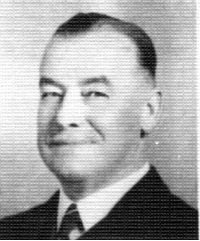
Date of Birth: 03/02/1879
Place of Birth: Barnsley, Yorkshire, England
Date of Death: 16/06/1952
Place of Death: Manly, New South Wales, Australia
Parliamentary Service
| President of the Legislative Council |
30 Apr 1946 |
16 Jun 1952 |
6 years 1 month 18 days |
|
| Deputy President of the Legislative Council |
25 Feb 1941 |
28 May 1941 |
3 months 4 days |
|
| Acting President of the Legislative Council |
27 Jul 1938 |
15 Dec 1938 |
4 months 19 days |
|
| Chairman of Committees |
02 May 1934 |
22 Apr 1936 |
1 year 11 months 21 days |
|
| Member of the NSW Legislative Council |
23 Apr 1934 |
16 Jun 1952 |
18 years 1 month 25 days |
A Member of the indirectly elected Council 1934 - 1978. Dates of Election 7 November 1933 and 14 March 1946. A Member before reconstitution. Granted retention of title of 'Honourable' for life. |
| Minister for Labour and Industry |
18 Oct 1927 |
03 Nov 1930 |
3 years 17 days |
|
| Minister for Labour and Industry |
13 Apr 1922 |
17 Jun 1925 |
3 years 2 months 5 days |
|
| Member of the NSW Legislative Council |
23 Jul 1912 |
22 Apr 1934 |
21 years 9 months |
Life Appointment under the Constitution Act. Date of Writ of Summons 29 March 1912. |
Political Party Activity
Australian Labor Party (ALP), member central executive 1908-1916, vice-president 1909, 1911, 1915-1916, president 1912-1913, expelled from ALP on conscription issue; vice-president National Association 1917-1932, founder and president of National Club Ltd; councillor United Australia Party 1933-1934.
Qualifications, occupations and interests
Saddle maker and union official. Arrival at Sydney 1879. Educated at Granville and Petersham public schools; worked as shearer, joined Australia Workers' Union at seventeen; later saddle maker and wool presser; went to Tasmania, New Zealand, and back to Tasmania, worked on North Kater's (q.v.) Mumblebone station, c1904; helped found Saddle and Harness Makers' Union 1902, New South Wales secretary and foundation president of Australia Saddlery Trades Federation 1907-1912; member executive of the Trades and Labor Council (TLC) from 1906, president 1910; president Eight Hour Committee 1911; president Board of Fire Commissioners 1915-1922; Commissioner Wembley Exhibition 1924; Chairman New South Wales Employment Council 1932; trustee and president Ku-ring-gai Chase, trustee Australia Museum and of Sydney Grammar School; president Allies Day Committee (1916); active Britain Empire Parliament Association; Protestant, attended Methodist Sunday School.
Membership of other Parliaments & Offices Held
Local Government Activity
Personal
Son of Henry, iron moulder, and Mary Elizabeth Buckley. Married Susan Whitfield in 1908 and had issue, one son. Northern Suburbs Cemetery from St Andrew's Church of England Cathedral. Church of England
Additional Information
Australian Dictionary of Biography, Volume 8
Personal papers in the Mitchell Library, State Library of New South Wales:
Ernest Henry Farrar - papers, 1917 - 1930 (MLMSS 2098); photographs in the
PICMAN Database.
Text from the book: 'The Presiding Officers of the Parliament of New South
Wales', Sydney, 1995
Ernest Henry Farrar was born on 3 February 1879 in Yorkshire in England and
arrived in Sydney the same year. He married Susan Whitfielde in 1908 and they
had one son. Working as a shearer and saddle maker throughout Tasmania, New
South Wales and New Zealand, Farrar showed an interest in the trade union
movement, joining the Australian Workers' Union at the age of seventeen. He was
a prominent figure in the development of the Saddle and Harness Makers' Union,
becoming its State Secretary in 1907. As a leading member of the Political
Labor League of New South Pales, Farrar became President of the Executive
between 1912 and 1915 and Vice President on three separate occasions between
1909 and 1916, when he was expelled over his support for conscription.
Subsequently he joined the National Party and was Vice President when it
changed its name to the United Australia Party.
Farrar was appointed to the Legislative Council in 1912 and remained a member
until his death in 1952. He was Minister for Labour and Industry from 1922 to
1925 and again between 1927 and 1930. He took an active interest in the plight
of the unemployed and as a member of the `roads and bridges government' he was
one of those responsible for initiating construction projects such as the Spit
Bridge, Tom Ugly's Bridge and the Sydney Harbour Bridge. Unanimously elected
President of the Legislative Council in 1946, his reputation for impartial
rulings enabled him to continue as President after Labor won control of the
Council in 1949. Farrar was an efficient manager of debates, but his strength
came from an extensive knowledge of the traditions the Legislative Council.
Perhaps his greatest legacy as President was the set of Standing Orders drawn
up under his instruction. In. 1946 he was called upon to cast the deciding vote
which defeated Labor's Council Abolition Bill. He died on 16 June 1952 while
still President of the Council.
